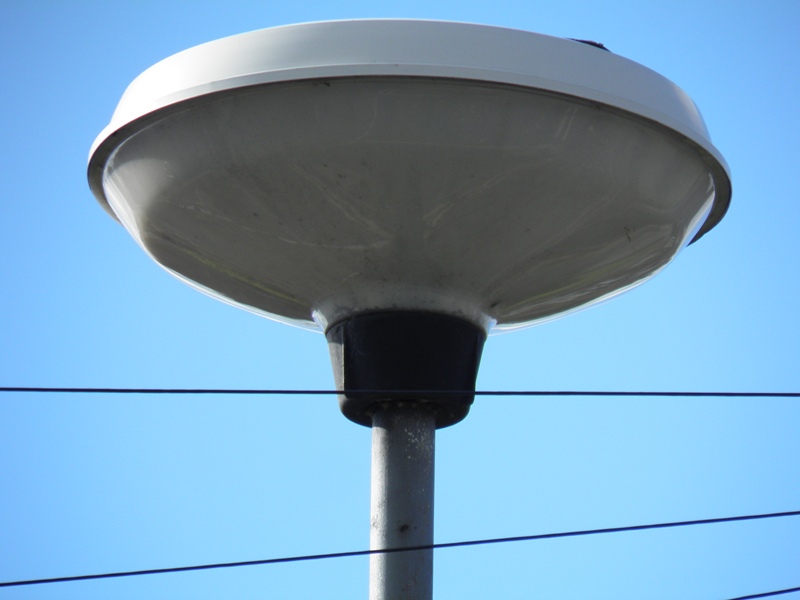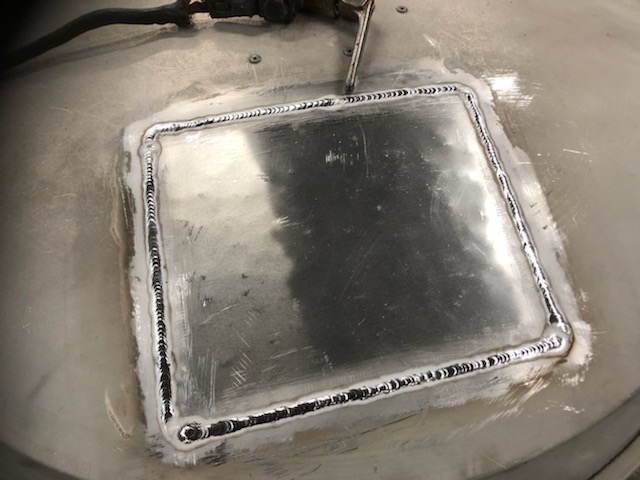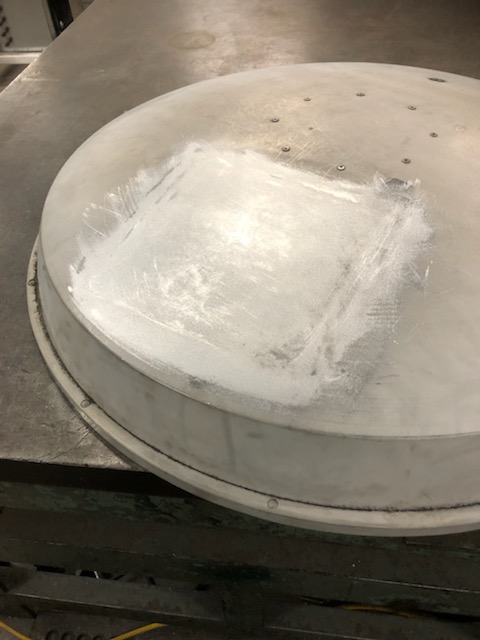
Thorn Gamma 4
Lantern acquired in September 2020.
This lantern was removed from the centre of a junction between Church Street and Rectory Road in Clowne, in the Bolsover District of Derbyshire, following the replacement of its 8 m tubular steel column, owing to the presence of a corrosion hole at ground level. The new column was equipped with a double arm outreach bracket, with both of the outreaches supporting a Thorn Isaro Pro-S 47 Watt LED lantern. This was the only known surviving Gamma 4 in Derbyshire, and so I was, understandably, keen to save it. Thus, I am very grateful to the contractors involved for exercising additional care when taking it down, particularly given its '"rather large" overall size! Remarkably, the Gamma 4's design dates from 1958 and the lantern (branded as an Atlas product at the time) went on to win a Design Council award two years later. This example is around twenty years newer than that, though the overall appearance changed little over the lantern's approximate thirty year production run. An example (probably an Atlas version) existed in Derby at the junction of Bateman Street and Osmaston Road in 1967, although how long it lasted after that is unknown.
The lantern, as seen when installed.

I had thought that the object visible on the top of the lantern's canopy was a Royce Thompson P10 photocell...the truth, as we shall see, is far different!

This photograph does not do the lantern's immense size justice at all - this mighty Post-Top measures 914 mm (3 feet) in width and 514 mm (1.68 feet) in height, with a maximum weight (depending on the lamp type and quantity) of 18.82 kg (41.49 lb) being possible! Amusingly, Thorn produced an even larger version, which measured 1219 mm (4 feet) in width and 597 mm (1.95 feet) in height, with that version having a maximum weight of 21 kg (46.30 lb)! By comparison, the GEC ZD10606 measures a miniscule 833 mm (33 inches) in width, and is 482 mm (19 inches) in height. Unusually, the canopy does not lift off, as it does with sister lanterns, the Gamma 3 and 5. Instead, the thick aluminium casting below the bowl is meant to unscrew and drop down onto the bolts that have been fastened into the column shaft below, with the bowl then able to be lowered too - the canopy being fixed to an internal core within the lantern that bolts to the top of the column. Expecting the casting to be loose from frequent re-lamps, I asked that the column be cut beneath the bolts, in order to allow the lantern to be opened normally. Of course, Thorn Lighting had other ideas...
The casting should act as a giant wing nut, with fins spaced at 120 degree intervals serving as hand grips. Whilst this version was designed for symmetrical area lighting, an alternative version incorporated reflectors, for use in producing an asymmetrical distribution when the lantern was installed at the side of the road.
The outer part is meant to unscrew from the inner...but the join between the two looks ever so slightly corroded from this angle!
Apparently, someone else had discovered that the casting was jammed during a previous repair visit (or simply, didn't realise how to open the lantern!), resulting in a neat oblong being cut in the canopy, allowing access to the lamps to be gained from above! A section of a steel "temporary" column door had been cut to patch the gaping hole, and screwed into place, with some sort of mastic being used to try to seal the panel. Of course, the panel would have had to be opened every time the lamps required changing, meaning that this sealant would have been destroyed quite quickly; indeed, all these years later, it has hardened and become brittle. On the other side of the canopy from the "escape hatch", a Zodion SS55 two-part photocell detector can be seen.
A close-up of the panel. A very faint Pudsey Diamond logo, complete with a pre-1995 telephone area code, is visible.
The aluminium is cut quite crudely below the panel (I take back the "neat oblong" comment!), with the corners of the aperture being drilled initially, and then cuts made between the holes.
Peering through the aperture reveals the Gamma 4's internal construction - the central core rises up inside the lantern to a point where (I assume) the cable terminations for the lampholders are located. Three spokes link the central core to the canopy. The lantern ran two 150 Watt SON-T lamps, although this option wasn't listed officially in Thorn literature until 1984; until then, the official lamp options were two or three 250 Watt - 400 Watt MBF (mercury vapour), SON (high pressure sodium) or MBI/F (metal halide) lamps. Earlier catalogues stated that two 500 Watt GLS (tungsten filament) lamps, or three 135 Watt SOX / 140 - 200 Watt SLI/H lamps (4 ft version only), were all options too. Notice that one of the two lamps is heavily blackened - a nearby resident watching the column being replaced commented to me that both lamps hadn't worked in a long time. A small hole has been drilled in the central section, in order to accommodate the wiring for the two-part detector.
Three bolts located on the inside of the casting secure the lantern to the column. These also appear to be jammed, though as I am unable to lower the outer part, and thus, the bowl, I have not been able to obtain a strong enough fixing to test this for certain. Amazingly, the lantern is fairly clean internally, with only a small amount of dirt gathered in the lip around the base of the bowl.
Both of the Philips-made 150 Watt SON-T lamps looked rather worn, though the lower one had failed so long ago (but still connected up) that its arc tube had blown itself in half, resulting in the characteristic dark mirroring that is present on the inside of the lamp's outer bulb. Curiously, both lamps have a 5-suffix date code, which would suggest that both were made in 2005, with the failed one being made in February (B), and the better one being made in December (M); however, I believe that there could be a printing error with the better lamp's date code - instead of this being displayed as 'M5', my suspicion is that it should show '5M', which would represent December 2015 instead. This lamp also includes the "Crossed-out Wheelie Bin" pictogram that represents the Waste Electrical and Electronic Equipment (WEEE) Directive, which came into force in 2005. As this is absent from the failed lamp, it is reasonable to assume that it does date from this year.
The lantern seems to have gone through a few control gear component replacements in its time, with one lamp circuit being run by a Philips BSN 150 L34 ballast, SN 58 ignitor and L5020 20 µF capacitor (dating from week 38 of 2002 (the 16th - 22nd September - appropriately, the lantern was removed from service on the 17th September 2020)); the other run on a Thorn G53335.T ballast (installed in May 1990), G53282/A ignitor (installed in October 1984) and Pye G.C2331/TM/L capacitor from week 27 of 1981 (the 29th June - 5th July), which may be the only original component remaining. The SS55 two-part photocell relay was made in February 2014.
Disassembly of the lantern began on Saturday, 3rd October. Fortunately, the panel cut into the canopy provided sufficient space for me to remove one of the three support spokes, and to loosen one of the others. This allowed enough of a gap to form between the canopy and bowl for the third to be loosened too, and eventually, all spokes were unfastened, and the canopy could be removed. Although much of the canopy is aluminium, the central ring for supporting the lantern's central core, along with the outer rim that the top of the bowl rests on, are steel - in the case of the latter, surface rusting has formed at the point where the gasket has become damp and been pressed against the steelwork.
The central core comprises a cylindrical conduit section linking the threaded base to a plate above the lampholders where the wiring connects.
Another view of one of the internal bolts that fixes the lantern to the column - even with them now being more accessible, trying to turn them still wasn't happening. There is also a threaded nut on the inside of the casting that holds the conduit steady - or should do!
Two three-terminal porcelain terminal blocks are located in the top section, with unused holes suggesting that further blocks could be included on versions of the lantern that employed more lamps. The note below the left-hand block states that the cores of the incoming cables should be encased with heat-resistant sleeving, owing to the high temperatures that would be present in this area - something that did not happen with this lantern. The incoming cables pass up inside the central core. The smaller label visible states that this is a Mark 14 version of the Gamma 4.
Amazingly, despite my thoughts that removing the remains of the old column, and the base casting, would be a complete nightmare, once the spine was taken to the workshops of TAS Engineering, of Burton-upon-Trent, removal proved to be rather straightforward. Thus, while the now-freed two-part base casting was sent away for blasting and repainting, the rest of the spine was disassembled (the GES E40 lampholders turned out to carry Thorlux branding, interestingly) and placed in the automatic lantern cleaning device (the dishwasher!). Doing this returned a shine to the piece, as well as removing sooty deposits above where around forty years' worth of lamps had been installed. Removing the base casting also revealed a total of four locknuts...unless it isn't painfully obvious already, I truly adore the engineering that went into the Gamma 4's design.
The wiring terminations at the top cleaned up especially well. Notice that the two neutral conductors are now completely separated, rather than sharing a terminal as they did previously - this is because I intend to run both circuits independently, with separate wiring to both.
TAS was able to repair the hole in the canopy too - the crudely-cut aperture was cut further, in order to make the hole a more regular shape. A fresh piece of aluminium sheet was cut to size and welded into place.

Afterwards, the welds were sanded down, in order for the new piece to match the profile of the surrounding canopy.

The restored base section returned from repainting by a local refurbishment company on Friday, 12th February 2021. The 'inner' part of the base is cast iron (which explains why the lantern was surprisingly heavy when removed), whilst the 'outer' part is cast aluminium. A very coarse thread attaches the two together.
With the column attachment bolts now accessible, rotating them is easy.
The base and spine sections were reunited - interestingly, the two locknuts located within the base can only be made finger-tight - the combination of the narrow 76 mm (three inch) diameter column spigot and wide locknuts preventing spanners or similar tools from tightening the locknuts any more satisfactorily.
A steel enclosure that could accommodate two 150 Watt electronic ballasts (for ease and portability) was sourced, and the ballasts installed therein. An MK Grid Plus surface box housing two double-pole switches was attached to the enclosure's lid, in order to allow the two lamp circuits to be switched individually, as mentioned earlier.
The two HID-PV C 150 / CDM ballasts are intended for running metal halide lamps, but will run SON lamps without issue too.
The final task for TAS on this project was to fabricate a 2 m column to accommodate the lantern. They even managed to replicate the design of the support pegs that the base casting rests on during maintenance - these screw into the column. The column is made up of two sections that bolt together - this allows for improved portability. The metalwork was then taken to the same local painting company to be finished in RAL 6006 (Derbyshire Green). Upon its completion, I sprayed on the maintenance number that had been applied to the old column when in service.
I hadn't appreciated that the section of the column that fits inside the lantern reduces in diameter, from the rest of the column being 89 mm (3·5 inches). Only when the lantern spine was freed did this become apparent, and was also incorporated into the fabrication.
The exterior of the canopy was painted light grey.
The interior, meanwhile, saw gloss white paint applied.
The photocell detector was then reinstated, although it won't be used. A new self-adhesive gasket strip was applied around the circumference of the canopy. During this process, I noticed for the first time just how severe the corrosion to the steel internal band had been - at the part where the rusting was at its worst, a small area of the steel had rotted through - the lantern was retired just in time, it would seem!
The three spokes were re-attached next. Out of curiosity, I fitted the central spine temporarily too, and secured it in place. The lantern couldn't be left in this state, however, as there is no way of accessing the wiring with the spine attached to the canopy.
Reassembly took place on Friday, 23rd April 2021. The spine was added first, and wired up using a five-core flexible cable (for the two lamp circuits, with a common earth conductor). Don't worry; the crack in the ceiling is nothing to do with the lantern's installation!
The bowl was slid into place next, and then the canopy attached to the spine.
Two new Thorn 150 Watt SON-E lamps from April 1980 or 1988 were screwed into place.
Before the bowl and base section were raised, I decided to check that both lamp circuits, along with the lamps themselves, operated correctly; they did indeed, and within a few minutes, rather a lot of golden light was being emitted from beneath the canopy!
The bowl was raised, and the full, complete appearance was seen for the first time in many years.
The slight translucence to the bowl allowed the positions of both lamps to be seen from below.
Here's the lantern operating with only one of its lamp circuits - how the lantern would have looked by the time that it was due for removal.
With that, restoration of the three foot monster was complete...now to find a four foot version!
Testing with my energy monitoring device revealed the following results, with both lamps activated:
| Test Voltage (V) | Current being drawn at full power (A) | Measured wattage (W) | Apparent Power (VA) | Frequency (Hz) | Power Factor | True Power (W) | Difference to rated wattage (2 × 150 Watt) | Percentage Difference |
| 241.9 | 1.33 | 312 | 322 | 49.9 | 0.97 | 312.08 | 12.08 | 4.03% |
Lantern operation video:
Atlas Gamma 8 | Thorn Pilote T1
CLICK HERE TO MAKE A MONETARY DONATION
© 2002 - English Street Lights Online